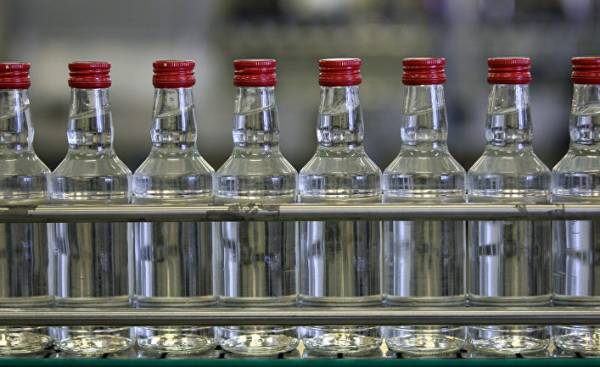
Russians love to drink, this fact is known all over the world. However, compared to Americans and Europeans, who in a state of alcoholic intoxication behave impeccably, even during working time, Russian when you drink alcoholic beverages, do not know the steps, and sometimes even have only one purpose — to get drunk, and then feel pretty relaxed, so a large number of conflicts, accidents, crimes occur under the influence of alcohol. Cause alcoholism is often a divorce or the death of loved ones.
According to the data published in the Russian newspaper in 2016, from alcoholism in Russia have killed more than 500 thousand people every year, 30% of deaths among men and 15% among women is due to alcohol. In the 1990-ies the problem of alcoholism in Russia have been ranked to a humanitarian catastrophe. Many Russian literary works raise the problem of alcoholism. Recently, the film “the Fool”, which received critical acclaim. The film tells about the life of one drunk, shows their living conditions, which leave no one indifferent.
In December last year in the Russian Irkutsk for bath products under the name “Hawthorn” (which is considered good for the skin) passed away 76 people. The use of substitutes of alcohol is considered the highest form of alcohol dependence.
(1)
How was it possible to have a bath? It’s very simple, because the alcohol content in the product reaches 93% at 250 ml, and the product cost only 60 rubles. For alcoholics who have, there is always money for vodka, “Hawthorn” is a good alternative.
In Russia, many drinkers take the “Hawthorn” but 76 died very lucky: they got a fake product, which used methanol instead of ethanol. In August 2014 the Russian government has raised the minimum price of vodka from 89 to 220 rubles, then the price dropped to $ 190 rubles, but in may again increased to 205 rubles. In many regions average salary is 6000-8000 rubles, which means that in a month you can buy about 40 bottles of vodka, if not to eat and to drink. For many alcohol addicts are not enough, so the “Hawthorn” is popular.
 © RIA Novosti, Yevgeny Vadim epanchitsev | go to fotomontagen the vending machine for alcohol with means hawthorn
© RIA Novosti, Yevgeny Vadim epanchitsev | go to fotomontagen the vending machine for alcohol with means hawthorn
If people can’t afford vodka, they start to consume other alcohol-containing products. It is a mainly Russian phenomenon. After raising the price of vodka in 2014, the struggle against alcoholism in Russia. Vladimir Putin said that the Russian government is acting with caution because the history of Russia there were cases of complete alcohol prohibition, which led to serious consequences. People started to make moonshine and drink toxic alcohol products.
Nobody expected that the increase in the price of vodka to 200 rubles will be able to trigger the growth of production of counterfeit alcoholic products. According to the 2014 hospital of St. Petersburg due to alcohol poisoning was hospitalized about 2 thousand people, in 2015 this figure rapidly increased to 6 thousand. In 2016, the hospital got about 9 thousand people.
In addition to “Hawthorn,” people also prefers Cologne, liquid glass cleaner, brake fluid, cooler, alcohol-containing cosmetics. After the price increase on vodka sales of the beverage plummeted, and sales of alcohol-containing cosmetics (“Hawthorn”) increased from 569 mirjalilov in 2013 to 1008 in 2014, and in 2015 the number reached 2025 mililitros. This increase in sales can be explained only by the fact that people who are addicted to alcohol, began to buy these products instead of conventional expensive vodka. According to the research center for the study of the alcohol market, after the poisoning “Hawthorn” conducted a study, which revealed that approximately 10% of the population uses the products-substitutes of vodka.
In that case, why the Russian government again began to regulate the price of vodka? In 2013, it introduced double the sales tax of vodka, and after price regulation is lifted part of the tax. The latter regulation was conducted by the Russian Ministry of Finance.
The fight against alcoholism is not convincing in the eyes of the people. Actually, more like the fact that Russia under the guise of struggle with alcoholism trying to patch a hole in the financial system. At the end of 2015, the Chairman of the Federation Council Valentina Matvienko said that the control over the production of vodka for the past three years has decreased by 35%. Policies most concerned about the financial losses: “the Losses amounted to 2 – 2.7 billion rubles.”
In 1981, the Soviet government raised prices for vodka, as the Afghan war was costly. In 1980 on the international market plummeted the price of oil. The Soviet people were forced to replace oil revenues on increased consumption of alcohol. The current situation resembles the events of 30 years ago.
(2)
Turning to the history of Russia, you can see that addiction to alcohol to Russian was formed long ago. For example, vodka could give change when buying and this was not unusual.
In Russian traditional polytheistic religion there is nothing associated with the intake of alcoholic beverages. In 1147, in Russia appeared the first written sources testifying to the emergence of alcohol. Until the XVI century in Russia there were beverages of a strength of 5-10 degrees, to the same people drink it only on holidays and not more than 120 ml for a few people. Some managed to get drunk, but it caused in society and the condemnation has sometimes been equated with crime. Until the sixteenth century in Russian classical literature has ever mentioned the phenomenon of drunkenness.
In the XV century, from Europe to Russia came the technology of making alcohol with high degree, and only if Russia first encountered the problem of alcohol abuse. In 1551 Stoglavy Cathedral in the Moscow Principality for the first time there was a following formulation: “we Must not drink for intoxication, but for the sake of God.”
However, four years after one hundred heads Cathedral of princes and boyars had the right to open private taverns, the so-called Tsarev kabaki. Everywhere began to emerge in the pub, vodka fell, people began to sleep. At the same time the Russians began actively to make moonshine. The reason is very simple: Ivan the terrible realized that the income from the sale of alcohol can quickly replenish the state Treasury. In the result of Royal promotion in Russia significantly increased the number of taverns, and from that moment, we can say, alcohol became part of the Russian culture.
Since then, Russia began to experience new social problems. For example, many people because of drinking got into debts that were subsequently not able to pay. The peasants began to postpone agricultural business, to the extent that land has been abandoned. In the XVI century, the British Ambassador in Moscow, wrote in his memoirs: “These poor workers and artisans spent all his money in taverns, many even changed their clothes in vodka and no clothes back home”. This led to popular discontent, the Church also opposed the consumption of alcohol. Then in the Russian society began to form a dismissive attitude to the drunks up to the fact that in the XVII century, a riot broke out against state policies that encouraged drinking alcohol. Russian Tsar Alexei Mikhailovich was forced to suppress the rebellion with the help of the army.
In 1652 Alexis had to introduce a number of restrictions in the Tsar’s taverns: during the year it is forbidden to sell alcohol more than 180 days, everyone is entitled to one glass (120 milliliters), it is forbidden to sell alcoholic drinks already drunk. However, very quickly appeared the following provision: to help the state Treasury, it was forbidden to throw drunks out of the tavern. In this position and reflected the original purpose of the creation of Tsarevo dives.
If at this stage the alcoholism caused the condemnation in the people, in the era of Peter I the drinking of alcoholic beverages has been officially approved.
Thanks to Peter I the Russian people are completely addicted to strong alcohol. The Emperor signed the order to free capital supplied spirits, of every day, relied 120 milliliters of alcohol. During the celebration of state holidays Peter personally served people example drink, turning any occasion into a huge binge. Russian nobility and officials, too, had too much to drink.
Thus alcohol became an integral part of Russian life. Peter I signed the decree: “as long as the person has some things besides the cross around his neck, not letting him out of the house”. Thus Tsarev kabaki more enriched and provided a financial management warrior. After Peter I Russian even more in love with wine, especially strong alcohol, and drunkenness was no longer condemned in the highest society. These changes were a result of the policy pursued by the government, and the state has greatly enriched because of the monopoly on alcohol products. Technologies of rectification and purification is extremely difficult, but the Russian people possessed it. Due to this, in the twentieth century, Russia officially launched production of pure vodka. When in the XVI century appeared Tsarev kabaki, the common people were forbidden to brew, and I noticed one interesting fact: drinking suffered mostly simple peasants, they bought alcohol in pubs, and Russian factories produced so much alcohol that it would be enough for the entire population of Russia. The amount of alcohol in the circles of the nobility was limited, so the nobles drank, not as much as the peasants.
Thus, the king tried to meet the financial needs of the state and pushing people into “the abyss of drunkenness.” During the reign of Catherine II in Russia was introduced monopoly on alcoholic beverages, and as a result the situation with alcoholism in the country began to deteriorate, and the state budget began to grow. During this period, there were no restrictions on drinking alcohol, the pub worked around the clock, people could drink at any time. Then Russia and became one of the most drinking countries in the world.
(3)
The state is directly sold to the people alcoholic beverages: the more people пьtт, the more enriched the country. However, there is one “but”: alcohol takes care of the people, and this is a political problem.
In 1858-1859, in the Russian village closed several thousand taverns. In Russia started the “temperance movement”. In the villages began to emerge in organizations in which people are discouraged from drinking alcohol. In July 1859 the Russian Orthodox Church decided to support this movement, priests are now obliged to help people in the fight against alcoholism.
But the government again intervened and struck the “temperance movement”. About 11 thousand people sat in jail for participating in it. It should be noted that the Ministry of Finance actively participated in this case, stating that “non-governmental organization calling for restrictions in the use of alcohol, can no longer exist”.
However, the “temperance movement” was not so easy to destroy, its members still tried to fight alcoholism and even has achieved certain successes, for example, saw a drop in alcohol sales. In 1906 the Russian government had to cancel the monopoly on alcohol production, returning to the system of state monopoly, as in the time of Alexei Mikhailovich. There were restrictions on the sale of alcoholic beverages in the capital and in large cities the sale of alcohol was allowed from seven to ten o’clock in the evening, in the country — up to eight hours, and the production of moonshine became illegal.
The Russian government thus reached a compromise, but it also reflected changes in the internal politics of the country. Defeated in the Russo-Japanese war in 1905, and after the first revolution the tsarist regime became a constitutional monarchy. The emergence of the Council was dictated by the will of the people. “Temperance movement” also turned into a kind of Council. During this period the consumption of alcohol declined substantially, as the level of crime, and the people began to show interest in the theatre, visits to the library. In a society originated new customs, for example, often have to be “sober wedding.”
In 1914 Russia entered the dry law. This was a seminal event for the country.
The famous scientist and doctor Mendelson wrote in his book that the introduction of prohibition in 1914 — an unprecedented event that led to a moment a few million people at once to stop drinking, and the results of such a policy should be very clear. He added that with the introduction of the dry law, the Russians began to invest in banks instead of spending it on booze.
For eight months from August 1914 to March 1915, the total deposits grew by 260 million rubles, while in 1913-1914 it did not exceed 6.5 million.
Not to mention that the policy of prohibition of alcohol was very successful. She established a new system of values in society in which abstinence from alcohol is key, and many really got rid of alcohol addiction. If this policy lasted longer, maybe Russia would become a “normal state”. This time the prohibition of alcohol could succeed, “temperance movement” in 1905 urged the Russian government not to make past mistakes and not to make alcohol the main source of income.
 © RIA Novosti, Maxim Bogodvid | go to fotobabble vodka on the conveyor at the Kazan distillery
© RIA Novosti, Maxim Bogodvid | go to fotobabble vodka on the conveyor at the Kazan distillery
Unfortunately, the ban on alcohol was in force only until 1925. The Soviet government was forced to cancel it again for financial reasons. In 1930, Stalin writes a letter to Molotov: “it is Important to discard the sense of shame, and for the sake of building defenses, the state must greatly increase the volume of production of vodka”. Stalin even decided to introduce control over the system of production of vodka, which was carried out by KGB officers.
Lifting the ban, Russia will never come back to this policy, so now the number of people drinking alcohol is growing. Whether the situation after the Second world war or after the collapse of the Soviet Union, political conditions for alcoholism are not affected. In the period of Gorbachev vodka again became one of the main financial sources of the state, which caused the people’s resistance.
Therefore, the fact that Putin raised the price of vodka, does not cause me any surprise, and mass poisoning in Russia is simply the result of a penchant for alcohol. If Russia wants to get rid of this problem, the government needs to cease to consider alcohol to be a source of income. However, given that at the moment Russia is experiencing a severe shortage of money, this problem will hardly be solved “from above”.







